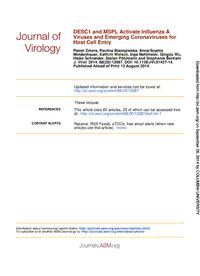
2014 DESC1 and MSPL Activate Influenza A Viruses and Emerging Coronaviruses for Host Cell Entry PDF
Preview 2014 DESC1 and MSPL Activate Influenza A Viruses and Emerging Coronaviruses for Host Cell Entry
Published Ahead of Print 13 August 2014. 2014, 88(20):12087. DOI: 10.1128/JVI.01427-14. J. Virol. Heike Schneider, Stefan Pöhlmann and Stephanie Bertram Moldenhauer, Kathrin Welsch, Inga Nehlmeier, Qingyu Wu, Pawel Zmora, Paulina Blazejewska, Anna-Sophie Host Cell Entry Viruses and Emerging Coronaviruses for DESC1 and MSPL Activate Influenza A http://jvi.asm.org/content/88/20/12087 Updated information and services can be found at: These include: REFERENCES http://jvi.asm.org/content/88/20/12087#ref-list-1 at: This article cites 60 articles, 33 of which can be accessed free CONTENT ALERTS more» articles cite this article), Receive: RSS Feeds, eTOCs, free email alerts (when new http://journals.asm.org/site/misc/reprints.xhtml Information about commercial reprint orders: http://journals.asm.org/site/subscriptions/ To subscribe to to another ASM Journal go to: on September 26, 2014 by COLUMBIA UNIVERSITY http://jvi.asm.org/ Downloaded from on September 26, 2014 by COLUMBIA UNIVERSITY http://jvi.asm.org/ Downloaded from DESC1 and MSPL Activate Influenza A Viruses and Emerging Coronaviruses for Host Cell Entry Pawel Zmora,a Paulina Blazejewska,a Anna-Sophie Moldenhauer,a Kathrin Welsch,a* Inga Nehlmeier,a Qingyu Wu,b Heike Schneider,c Stefan Pöhlmann,a Stephanie Bertrama* Infection Biology Unit, German Primate Center, Göttingen, Germanya; Molecular Cardiology, Nephrology, and Hypertension, Lerner Research Institute, Cleveland Clinic, Cleveland, Ohio, USAb; Institute for Physiological Chemistry, Hannover Medical School, Hannover, Germanyc ABSTRACT The type II transmembrane serine protease (TTSP) TMPRSS2 cleaves and activates the influenza virus and coronavirus surface proteins. Expression of TMPRSS2 is essential for the spread and pathogenesis of H1N1 influenza viruses in mice. In contrast, H3N2 viruses are less dependent on TMPRSS2 for viral amplification, suggesting that these viruses might employ other TTSPs for their activation. Here, we analyzed TTSPs, reported to be expressed in the respiratory system, for the ability to activate influ- enza viruses and coronaviruses. We found that MSPL and, to a lesser degree, DESC1 are expressed in human lung tissue and cleave and activate the spike proteins of the Middle East respiratory syndrome and severe acute respiratory syndrome coronavi- ruses for cell-cell and virus-cell fusion. In addition, we show that these proteases support the spread of all influenza virus sub- types previously pandemic in humans. In sum, we identified two host cell proteases that could promote the amplification of in- fluenza viruses and emerging coronaviruses in humans and might constitute targets for antiviral intervention. IMPORTANCE Activation of influenza viruses by host cell proteases is essential for viral infectivity and the enzymes responsible are potential targets for antiviral intervention. The present study demonstrates that two cellular serine proteases, DESC1 and MSPL, activate influenza viruses and emerging coronaviruses in cell culture and, because of their expression in human lung tissue, might pro- mote viral spread in the infected host. Antiviral strategies aiming to prevent viral activation might thus need to encompass in- hibitors targeting MSPL and DESC1. I nfluenza A viruses (FLUAVs) and the emerging pathogens se- vere acute respiratory syndrome coronavirus (SARS-CoV) and Middle East respiratory syndrome coronavirus (MERS-CoV) are respiratory viruses that pose a significant threat to human health. Annual influenza epidemics cause 250,000 to 500,000 deaths worldwide (1), and intermittent pandemics can have even more severe consequences, as exemplified by the devastating Spanish influenza of 1918, which is estimated to be responsible for 30 to 50 million deaths (2). The SARS-CoV emerged in southern China in 2002, and its subsequent spread, mainly in Asia, was responsible for 774 deaths (3). A related virus, the MERS-CoV, emerged in the Middle East in 2012 (4), and new cases of MERS-CoV infection continue to be reported in July 2014, with the total number of cases amounting to 834, of which 288 took a fatal course (5). Therefore, the development of novel strategies to combat FLUAV and emerging CoVs is urgently required, and host cell factors es- sential for viral spread but dispensable for cellular survival are attractive targets. The viral hemagglutinin (HA) and spike (S) surface proteins are responsible for host cell entry of FLUAV (6) and CoVs (7, 8), respectively. Both proteins use their N-terminal surface units, termed HA1 (FLUAV) and S1 (CoVs), to engage cellular recep- tors, while the C-terminal transmembrane units, termed HA2 (FLUAV) and S2 (CoVs), facilitate fusion of the viral membrane with a host cell membrane—processes that are essential for infec- tious entry (6–8). Notably, the HA and S proteins are synthesized as inactive precursors in infected cells and acquire the ability to drive membrane fusion only upon activation by host cell proteases (9, 10). Activation refers to proteolytic separation of the surface and transmembrane units, which is essential for viral infectivity. Consequently, the proteases responsible for HA and S protein activation are potential therapeutic targets. It has been suggested that several proteases secreted in the lung lumen can activate FLUAV (11–13). However, examination of cultured human respiratory epithelium revealed a key role for membrane-associated proteases (14), and work by Böttcher and colleagues identified the transmembrane serine proteases TMPRSS2 and HAT as potent activators of FLUAV (15), at least upon engineered expression in cell lines. Subsequent studies showed that endogenous expression of TMPRSS2 in cell lines can support trypsin-independent FLUAV spread (16, 17), and coex- pression of TMPRSS2 and 2,6-linked sialic acid has been demon- strated in most parts of the human airways (18), suggesting that TMPRSS2 might support FLUAV spread in the infected host. In- deed, work by Hatesuer and colleagues demonstrated that knock- out of Tmprss2 in mice largely abrogates the spread of FLUAV and Received 19 May 2014 Accepted 1 August 2014 Published ahead of print 13 August 2014 Editor: Douglas S. Lyles Address correspondence to Stefan Pöhlmann,
